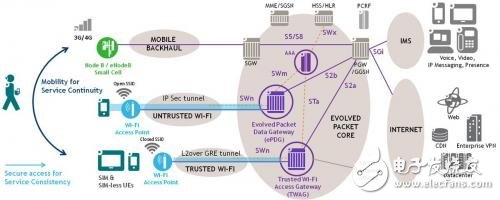Users in the Internet age have high requirements for business experience, including voice services. This can explain to some extent the development of the VoLTE business is relatively flat compared to the global LTE construction climax. As the first true carrier-grade IP public voice service, VoLTE puts high demands on the operator's network. Compared with some technical issues, LTE's network coverage coverage problem is more prominent. From the perspective of some commercially available VoLTE markets, they are not fully rolled out at first, but are gradually developed according to the actual situation of LTE network deployment in various regions. In these markets, although the coverage of LTE and the function of switching to 3G networks are relatively complete, there are still some areas (such as indoors) that make the VoLTE experience not perfect.
According to market research firm ABI Research, the global deployment of Wi-Fi hotspots will increase to 7.1 million by 2015 and will continue to maintain a CAGR of 15% between 2013 and 2018. There will be more than 105 million by then. These massively deployed Wi-Fi hotspots have greatly improved people's online experience, so can these Wi-Fi hotspots improve the voice communication experience in the LTE era?
How is this VoWi-Fi different from the past?The release of the iPhone 6 in 2014 made the VoWi-Fi technology that had appeared many years ago once again attracting people's attention. If you just talk about carrying voice services over Wi-Fi, the heat of interest will quickly dissipate. Because VoWi-Fi, which is not supported by the carrier-class business experience, will only exist in niche markets and cannot be truly integrated into the public network.
VoLTE uses IMS as the core control architecture. IMS is widely regarded as a technical architecture that supports full-type access in the future, and is the basis for the convergence of fixed and mobile networks. As an open control architecture, IMS has the ability to provide unified services to all types of access networks through a unified platform for the first time in the history of communications. In the development of standards, 3GPP has considered multiple access technologies including Wi-Fi in the 3GPP access architecture.
In the 3GPP specification, Wi-Fi access is considered to be a non-3GPP wireless access category, and operators can regard it as a trusted network and an untrusted network according to actual conditions. For these two types of networks, 3GPP introduces two new network elements:
Evolved Packet Data Gateway (ePDG) – used for untrusted Wi-Fi network access Trusted Wireless Access Gateway (TWAG) – used to trust Wi-Fi network access

The above architecture solves the following important problems for the Wi-Fi network access 3GPP network: the security access problem of the user terminal: the secure transmission of the authentication service flow by the AAA server and the HSS: Wi-Fi terminal Service continuity when switching between ePDG or AP to TWAG using security technologies such as encryption protocols and tunnels: The IP address of the user terminal is uniformly allocated through the PGW.
It can be seen from the above architecture that VoWi-Fi provides carrier-class voice services in the public communication network for the first time in a way of secure access, centralized authentication, and guaranteed service quality.
The benefits of VoWi-Fi to usersObtaining mobile, continuous carrier-grade voice services between LTE base stations and Wi-Fi hotspots (even outside LTE coverage) is easy to use, enabling automatic network discovery and authentication. A strong security architecture ensures Wi-based -Fi access is also secure and reliable. Wi-Fi access can also get operators' discounts on tariffs.
Benefits of VoWi-Fi to operatorsIncreased network coverage and network access capacity: Operators or virtual operators can selectively connect various widely deployed Wi-Fi hotspots to their mobile networks quickly and securely.
Improve user service experience, increase user stickiness, optimize service access, and divert traffic to roaming services or video services with high bandwidth requirements through Wi-Fi.
The ability to extend services to Wi-Fi access networks is increased, which allows operators to manage multiple terminals accessed via Wi-Fi as a whole.
MWC2015 witnesses seamless VoWi-Fi/VoLTE overall solutionUndoubtedly, as a useful complement to VOLTE, VoWi-Fi can bring a more perfect communication experience in the LTE era. Alcatel-Lucent will showcase end-to-end VoWi-Fi commercial solutions at MWC2015 and use commercial terminals for on-site VoWi-Fi service demonstrations. Combined with leading vIMS technology and native API technology, customers can experience new services such as video offload, fast service coverage, multi-terminal service selection and roaming.
Capacitor For Power Transmission And Transformation
Capacitor for power transmission and transformation
New Parallel Capacitor 100Kvar,Capacitor Banks,High Voltage Capacitor Banks,Parallel Capacitor 200kar
YANGZHOU POSITIONING TECH CO., LTD. , https://www.cnfudatech.com
